Qingdao
Qingdao
青岛市 Tsingtao | |
|---|---|
Prefecture-level and Sub-provincial city | |
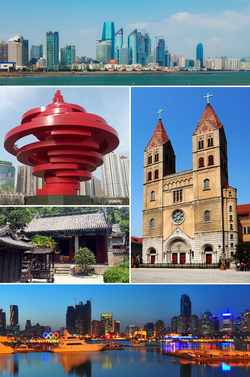 Clockwise from top left: Qingdao's skyline, St. Michael's Cathedral, Qingdao harbor, a temple at the base of Mount Lao, and May Fourth Square | |
 | |
 | |
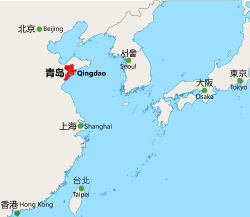 Location of Qingdao city (red) on China's eastern coast | |
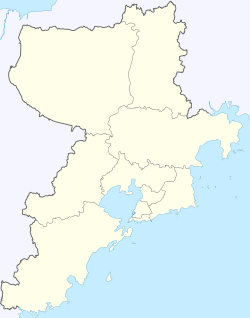 Qingdao Location of the municipal government | |
| Coordinates (Qingdao municipal government): 36°04′01″N 120°22′58″E / 36.0669°N 120.3827°ECoordinates: 36°04′01″N 120°22′58″E / 36.0669°N 120.3827°E | |
| Country | China |
| Province | Shandong |
| Lease to Germany | 6 March 1898 |
| Japanese occupation | 7 November 1914 |
| Return to China | 10 December 1922 |
| Japanese Occupation | 10 January 1938 |
| Return to China | 15 August 1945 |
| Municipal seat | 11, Xianggangzhong Rd, Shinan District |
| Government | |
| • Type | Sub-provincial city |
| • Body | |
| • CCP Secretary | vacant as of January 2021 |
| • Chairman | Wang Luming |
| • Mayor | Zhao Haozhi |
| • CPPCC Chairman | Yang Jun |
| Area | |
| • Prefecture-level and Sub-provincial city | 11,067 km2 (4,273 sq mi) |
| • Land | 11,067 km2 (4,273 sq mi) |
| • Urban (2018)[1] | 1,632 km2 (630 sq mi) |
| • Metro | 5,019 km2 (1,938 sq mi) |
| Population (2020) | |
| • Prefecture-level and Sub-provincial city | 10,070,000 |
| • Density | 910/km2 (2,400/sq mi) |
| • Urban (2018)[1] | 5,930,000 |
| • Urban density | 3,600/km2 (9,400/sq mi) |
| Time zone | UTC+8 (China Standard) |
| Postal code | 266000 |
| Area code(s) | 0532 |
| ISO 3166 code | CN-SD-02 |
| GDP | ¥ 1.2 trillion (US$140 billion) |
| GDP per capita | ¥ 127,745 (US$18,000) |
| License Plate Prefix | 鲁B & 鲁U |
| Coastline | 862.64 km (536.02 mi) (inclusive of offshore islands) 730.64 km (454.00 mi) (exclusive of islands) |
| Major Nationalities | Han: 99.86% |
| County-level divisions | 10 |
| Website | www.qingdao.gov.cn |
| Qingdao | |||
|---|---|---|---|
 "Qingdao" in Simplified (top) and Traditional (bottom) Chinese characters | |||
| Chinese name | |||
| Simplified Chinese | 青岛 | ||
| Traditional Chinese | 青島 | ||
| Postal | Tsingtao | ||
| Literal meaning | "Cyan Isle" | ||
| |||
| German name | |||
| German | Tsingtau | ||
Qingdao (/tʃɪŋˈdaʊ/, also spelled Tsingtao; Chinese: 青岛, Mandarin: [tɕʰíŋtàu]) is a major city in eastern Shandong Province. Located on China's Yellow Sea coast, it is a major nodal city of the One Belt, One Road (OBOR) Initiative that connects Asia with Europe.[2] It has the highest GDP of any city in the province. Administered at the sub-provincial level,[3] Qingdao has jurisdiction over six districts and four county-level cities. As of 2020, Qingdao has an urban population of 6,232,000.[4] Lying across the Shandong Peninsula and looking out to the Yellow Sea, it borders the prefecture-level cities of Yantai to the northeast, Weifang to the west and Rizhao to the southwest.
Qingdao is a major seaport and naval base, as well as a commercial and financial center. It is home to electronics multinationals such as Haier and Hisense. The Jiaozhou Bay Bridge, links the main urban area of Qingdao with Huangdao district, straddling the Jiaozhou Bay sea areas. Its historic, German-style architecture and Tsingtao Brewery, the second largest brewery in China[5] are legacies of the German occupation (1898-1914).
In the 2020 Global Financial Centers Index, Qingdao ranked 47th; the index is published by the Z/Yen Group and China Development Institute, the other Chinese cities on the list being Shanghai, Hong Kong, Beijing, Shenzhen, Guangzhou, Chengdu, Nanjing, Xi'an, Tianjin, Hangzhou, Dalian, and Wuhan.[6] In 2007, Qingdao was named as one of China's top ten cities by the Chinese Cities Brand Value Report, which was released at the 2007 Beijing Summit of China Cities Forum.[7] In 2009, Qingdao was named China's most livable city by the Chinese Institute of City Competitiveness.[8][9] In 2018, Qingdao held the Shanghai Cooperation Organization summit.[10] In 2020, Qingdao was rated as a Gamma+ level global city by the Globalization and World Cities Research Network.[11]
Qingdao is also a major city for global scientific research as tracked by the Nature Index according to the Nature Index 2020 Science Cities.[12] The city is home to several notable universities, including the Ocean University of China, one of China's prestigious universities as a member of Project 985, and China University of Petroleum (East China), a member of the Project 211.
History[]
Ancient times[]
Human settlement in the area dates back 6,000 years. The Dongyi nationality, one of the important origins of the Chinese nation, lived here and created the Dawenkou, Longshan and cultures. In the Eastern Zhou Dynasty (770 B.C. – 256 B.C.), the town of Jimo was established, which was then the second largest one in the Shandong region. The area in which Qingdao is located today was named Jiao'ao (胶澳) when it was administered by the Qing Dynasty on 14 June 1891.
German and Japanese occupations[]


In 1891, the Qing Empire decided to make coastal Tsingtao (then known as "Jiao'ao") a defense base against naval attack and began to improve its fortifications. Imperial German naval officials observed and reported on this activity during a formal survey of Jiaozhou Bay in May 1897. Subsequently, German troops seized and occupied the fortification.[13] The preindustrial, waning Qing Empire was forced to concede the area to Germany the following year, and the Kiautschou Bay concession, as it became known, existed from 1898 to 1914 (Li 2005, p. 81). With an area of 552 km2 (136,000 acres; 213 sq mi), it was located in the imperial province of Shandong (alternately romanized as Shantung or Shan-tung) on the southern coast of the Shandong Peninsula in northern China. Jiaozhou was alternatively romanized as Kiaochow, Kiauchau, or Kiao-Chau in English, and Kiautschou in German; Qingdao was its administrative center. "The so-called Marktstrasse (Market Street) was nothing more than the old main street of the Chinese village of Tsingtao, and the buildings lining it were the former homes of fishermen and farmers. Having sold their property, they resettled their homes and fields in the villages further east."[14] Upon gaining control of the area, the Germans outfitted the impoverished fishing village of Tsingtao (Qingdao) with wide streets, solid housing areas, government buildings, electrification throughout, a sewer system and a safe drinking water supply, a rarity in large parts of Asia at that time and later.[15] The area had the highest school density and the highest per capita student enrollment in all of China, with primary, secondary and vocational schools funded by the Imperial German treasury and Protestant and Roman Catholic missions.[15] Commercial interests established the Germania Brewery in 1903, which later became the world-famous Tsingtao Brewery.[16] German cultural and commercial influences extended to other areas of Shandong Province, including the establishment of diverse commercial enterprises.
Identified by the German authorities as a strategically important port, Qingdao was administered by the Imperial Department of the Navy (Reichsmarineamt) rather than the Imperial Colonial Office (Reichskolonialamt). The growing Imperial German Navy based their Far East Squadron there, allowing the warships to conduct operations throughout the western Pacific. Beginning January 1898, the marines of III. Seebataillon were based at Tsingtao. Construction of the Jiaoji Railway began on 23 September 1899, and was completed in 1904.[17]
Siege of Tsingtao
10 sen (1914)
Before the outbreak of World War I (1914–1918), ships of the German naval forces under Admiral Count von Spee were located at central Pacific colonies on routine missions. The fleet then rendezvoused in the Marianas Islands to plan a transit back to Germany rather than be trapped in the Pacific by more powerful and numerous Allied fleets (British and Japanese).[note 1]
After a minor British naval attack on the German concession in Shandong (Kiautschou Bay concession) in 1914, Japanese Empire troops occupied the city and the surrounding province during the Siege of Tsingtao after Japan's declaration of war on Germany in accordance with the Anglo-Japanese Alliance.[18] China protested against Japan's violation of her neutrality but was not able to interfere in the military operations.[19] The decision of the Paris Peace Conference and the Versailles Treaty negotiations not to restore Chinese rule over the previous foreign concessions in Qingdao after the Great War triggered the May Fourth Movement (4 May 1919) of anti-imperialism, nationalism and cultural identity in China.[20]
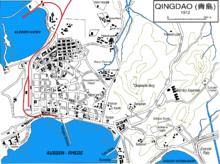
The city came under Chinese rule in December 1922, under control of the Republic of China (R.O.C.) established 1912 after the Chinese Revolution the year before. However, Japan maintained its economic dominance of the railway and the province as a whole.[21] The city became a direct-controlled municipality of the ROC Government in July 1929.
Japan re-occupied Qingdao in 1938, a year after its expansion of the Second Sino-Japanese War (1937–1945), (a precursor to World War II, 1939–1945) with its plans of territorial expansion into China's coast. Nationalist (Kuomintang) ROC forces returned after the Japanese surrender in September 1945. On 2 June 1949, during the Chinese Civil War and shortly before the founding of the communist People’s Republic of China on 1 October 1949 the city was taken by Chairman Mao Zedong and his troops.
Qingdao city planning and development[]
1898–1914[]
The development of the Tsingtao urban space during the German-occupation (1898–1914) originated from the port. Mass urban construction began in 1898 with the relocation of Chinese dwellers along the coast.[22] With the completion of such series of mass construction projects such as wharves, the Tsingtao-Jinan Railway Line, Tsingtao Railway Station and locomotive works, a city was starting to take shape.[23] The area had the highest school density and highest per capita student enrollment in all of China, with primary, secondary and vocational schools funded by the Berlin treasury as well as Protestant and Roman Catholic missions.[24] In 1910, the Germans drew up for the second time the city planning of Tsingtao (Warner 2001, p. 33). The former urban area was extended for four times highlighted by the emphasis on the development of commerce and trade. Sun Yat-sen (1866–1925), leader of the Chinese Revolution of 1911 and subsequent first president of the Republic of China, visited the Tsingtau area and stated in 1912, "I am impressed. The city is a true model for China's future".[25]
1914–1922[]
The development of Tsingtao urban space continued during the first Japan-occupation period (1914–1922). In 1914, Tsingtao was taken over by the Japanese and served as a base for the exploitation of natural resources of Shandong and northern China. With the development of industry and commerce, a "New City District" was established to furnish the Japanese colonists with commercial sections and living quarters, which suggested a striking contrast to the shabby houses in the local Chinese zones (Li 2007, p. 133). In the meantime, a number of schools, hospitals and public buildings were constructed, followed by urban streets and intercity highways as well. The urban spatial layout continued to expand northward along the eastern bay area.
1922–1938[]
The development of Tsingtao urban space during the ROC-ruled period (1922–1938). This period saw the substantial progress of the urban development of Tsingtao. The government engaged itself in mass construction that gave birth to villa districts at the beach and bank groups in CBD. Plenty of public buildings and facilities for the purpose of entertainment and sports were completed. By the year of 1937, the urban population numbered 385,000(Lu 2001, p. 327). Tsingtao consequently distinguished itself as a prominent holiday resort and summer retreat.
1938–1945[]
The development of Tsingtao urban space during the second Japan-occupied period (1938–1945). Japanese armed forces returned to Tsingtao in 1938 and started to strive for the construction of the Greater Tsingtao in the following June. Accordingly, they worked out the city planning of the Greater Tsingtao and the City Planning of the Mother Town (Tsingtao City Proper), even though they had not had the opportunity to actualize either, respectively. The period in question did not witness much urban progress except for the logical construction of No. 6 Wharf, some Japanese residences and a small number of roads and streets (Lu 2001, p. 339).
Postwar[]
After World War II, the KMT allowed Qingdao to serve as the headquarters of the Western Pacific Fleet of the US Navy in 1945; however, its headquarters was transferred to the Philippines sometime in late 1948. On 2 June 1949, the CPC-led Red Army entered Qingdao and the city and province have been under PRC control since that time.
Since the 1984 inauguration of China's open-door policy to foreign trade and investment, Qingdao has rapidly developed into an ultramodern port city. It is now the headquarters of the Chinese navy's northern fleet. An early example of the open-door policy occurred on 5 November 1984, when three United States Naval vessels visited Qingdao. This was the first US port call in more than 37 years to China. USS Rentz, USS Reeves, and USS Oldendorf and their crews were officially hosted by the Chinese People's Liberation Army Navy (PLAN).
Northern Qingdao, particularly Shibei, Licang, and Chengyang districts, are now major manufacturing centers. The city has recently experienced a strong growth period, with a new central business district created to the east of the older business district. Outside of the center of the city, there is a large industrial zone, which includes chemical processing, rubber and heavy manufacturing, in addition to a growing high-tech area. Numerous local and national service companies, rather than manufacturers, are based in the city's southern district; this, as well as local wind patterns, allows Qingdao to enjoy clean, clear air year round.

Administrative divisions[]
The sub-provincial city of Qingdao has 7 districts (区; qū) and 3 county-level cities (市; shì):
| Subdivision | Chinese (Simplified) | Pinyin Romanization | Admin. Code[26] |
Land Area (km²) |
Urbanization Rate (%) |
Permanent Resident Population ('000s, 2010) |
Population Density (1/km²) |

1
2
Licang
Huangdao
Xihai'an Laoshan
Chengyang
Jimo
Jiaozhou
(city) Pingdu
(city) Laixi
(city) 1. Shinan
2. Shibei
|
|---|---|---|---|---|---|---|---|---|
| Districts | ||||||||
| Shinan District (city seat) | 市南区 | Shìnán Qū | 370202 | 30.01 | 100 | 544.8 | 18153.95 | |
| Shibei District | 市北区 | Shìběi Qū | 370203 | 63.18 | 100 | 1020.7 | 16155.43 | |
| Huangdao District (Xihai'an New Area) |
黄岛区 (西海岸新区) |
Huángdǎo Qū (Xīhǎi'àn Xīnqū) |
370211 | 2220.10 | 80 | 1392.6 | 627.27 | |
| Laoshan District | 崂山区 | Láoshān Qū | 370212 | 389.34 | 80 | 379.5 | 974.73 | |
| Licang District | 李沧区 | Lǐcāng Qū | 370213 | 95.52 | 100 | 512.4 | 5364.32 | |
| Chengyang District | 城阳区 | Chéngyáng Qū | 370214 | 553.20 | 80 | 737.2 | 1332.61 | |
| Jimo District | 即墨区 | Jímò Qū | 370282 | 1727 | 58.1 | 1177.2 | 681.64 | |
| County-level cities | ||||||||
| Jiaozhou | 胶州市 | Jiāozhōu Shì | 370281 | 1210 | 68.0 | 843.1 | 696.78 | |
| Pingdu | 平度市 | Píngdù Shì | 370283 | 3166 | 52.8 | 1357.4 | 428.74 | |
| Laixi | 莱西市 | Láixī Shì | 370285 | 1522 | 58.1 | 750.2 | 492.90 | |
Geographically, there are four districts (Shinan, Shibei, Licang and Laoshan) constituting a peninsula on the east coast of the Jiaozhou Bay as the core urban area, one (Chengyang) on the north coast and one (Xihai'an) on the west coast of the Yellow Sea.
- Defunct - Jiaonan city (Chinese: 胶南市; pinyin: Jiāonán Shì) - merged into Huangdao District (December 2012)
Geography[]


| Qingdao | ||||||||||||||||||||||||||||||||||||||||||||||||||||||||||||
|---|---|---|---|---|---|---|---|---|---|---|---|---|---|---|---|---|---|---|---|---|---|---|---|---|---|---|---|---|---|---|---|---|---|---|---|---|---|---|---|---|---|---|---|---|---|---|---|---|---|---|---|---|---|---|---|---|---|---|---|---|
| Climate chart (explanation) | ||||||||||||||||||||||||||||||||||||||||||||||||||||||||||||
| ||||||||||||||||||||||||||||||||||||||||||||||||||||||||||||
| ||||||||||||||||||||||||||||||||||||||||||||||||||||||||||||
Qingdao is located on the south facing coast of the Shandong Peninsula (German: Schantung Halbinsel). It borders three prefecture-level cities, namely Yantai to the northeast, Weifang to the west, and Rizhao to the southwest. The city occupies an area totaling 10,654 km2 (4,114 sq mi), and stretches in latitude from 35° 35' to 37° 09' N and in longitude from 119° 30' to 121° 00' E. The populated sections of the city are relatively flat while mountains spur up within city limits and nearby. The highest elevation in the city is located 1,133 meters (3,717 ft) above sea level. Of the total area of Qingdao, 15.5% is highland, while the foothill, plain and lowland areas constitute 25.1%, 37.8% and 21.7%, respectively. The city has a 730.64-kilometer (454.00 mi)-long coastline. Five significant rivers exceeding 50 kilometers (31 mi) in length can be found in the region.
Climate[]
Qingdao has a temperate, four-season, monsoon-influenced[28] climate that lies in the transition between the humid subtropical (Köppen Cwa) and humid continental (Köppen Dwa) regimes. Winters range from cool to cold and windy, but are generally dry, with a January average of −0.2 °C (31.6 °F). Summer is generally hot and humid, but very hot days are rare, with an August average of 25.4 °C (77.7 °F). Due to its proximity to the coast and location on a peninsula, compared to most inland areas of China, its spring is delayed by one month,[28] and the annual diurnal temperature variation is only 6.3 °C (11.3 °F); conversely, its fall is milder than inland areas in Shandong. The water temperature peaks at about 25 °C (77 °F) in late August. Thus, swimming is possible for two months on either side. The annual mean temperature is 12.96 °C (55.3 °F). Extremes since 1951 have ranged from −15.5 °C (4 °F) on 16 January 1958 to 38.9 °C (102 °F) on 15 July 2002.[29]
During the summer months, the beaches of Qingdao are afflicted by massive algal blooms. The decomposing algae release large amounts of hydrogen sulfide gas, which produces an offensive "rotten egg" odor. Sea lettuce blooms, which are partially caused by seaweed farming in Jiangsu Province, led local officials to declare a "large-scale algae disaster" in 2013.[30]
| showClimate data for Qingdao (1981–2010 normals) |
|---|
Demographics[]
| Year | Pop. | ±% |
|---|---|---|
| 1913[34] | 58,000 | — |
| 1953 | 916,846 | +1480.8% |
| 1964 | 1,383,433 | +50.9% |
| 1982 | 4,227,594 | +205.6% |
| 1990 | 6,663,989 | +57.6% |
| 2000 | 7,494,194 | +12.5% |
| 2010 | 8,715,100 | +16.3% |
| 2020 | 9,499,800 | +9.0% |
| Population size may be affected by changes on administrative divisions. | ||
Of the 10 million residents of Qingdao, 6.2 million reside in the Qingdao urban area. Another estimated 5 million live in other cities under Qingdao's jurisdiction.[4] The annual birth rate is calculated around 76,507, with a birth rate of 10.15 per year per thousand, and a death rate of 6.32, both calculated on an annual basis. Living standards are among the highest of leading Chinese cities due to the strong export economy and relatively high family wages.
There is a large Korean community in Qingdao. By 2009, there were approximately 100,000 Koreans working, studying and living in Qingdao, which makes Qingdao the second in terms of Korean population in China, following Beijing which has about 200,000 Koreans.[35]
Economy[]


An important region in Eastern China, Shandong Province has seen substantial change in its economic landscape in recent years. Much of this development has been concentrated in Qingdao.[36] Qingdao has seen rapid development. With an annual growth rate of 18.9 percent in 2006, the city's GDP reached 42.3 billion, ranking first in Shandong Province and tenth out of China's top 20 cities.[36] GDP per capita comprised CN¥52,895 (US$7,616) in 2008. The GDP has grown steadily at an average pace of 16% annually. In 2006, Qingdao was ranked one of six "golden cities" by the World Bank, out of 120 Chinese cities assessed on factors including investment climate and government effectiveness.[36] In 2018, Qingdao's GDP reached CN¥1200.15 billion, though it shrank a little in 2019.[37]
Internationally, Qingdao is perhaps best known for its Tsingtao Brewery, founded by a German-British joint venture in 1903 that produces Tsingtao beer, the best-known Chinese export beer. It is also home to Haier, a large white goods manufacturer, and Hisense, a major electronics company. In 2002 guitar manufacturers Epiphone opened a factory in Qingdao.[38]
In 1984 the Chinese government named a district of Qingdao a Special Economic and Technology Development Zone (SETDZ). Along with this district, the entire city had gone through amazing development of secondary and tertiary industries. As an important trading port in the province, Qingdao flourishes with foreign investment and international trade. South Korea and Japan in particular made extensive investment in the city. Approximately 80,000 South Korean citizens reside there.
In terms of primary sector industries, Qingdao has an estimated 50,000 acres (200 km2) of arable land.[citation needed] Qingdao has a zigzagging pattern coastline, and thus possesses an invaluable stock of fish, shrimp, and other sea resources.
Qingdao's wind power electricity generation performs at among the highest levels in the region.[39]
Industrial zones[]
- Qingdao West Coast New District
- Qingdao Special Economic and Technological Development Area
- Qingdao Free Trade Zone
- Qingdao High-tech Industrial Zone
- Qingdao University Industrial Zone
Transport[]
Road[]
There are a total of 1,145 km (711 mi) of roads in the Qingdao area, with nearly 500 km (310 mi) of expressways. These National Trunk Highway System (NTHS) Expressways begin or pass through in Qingdao.[40] Expressways that begin in Qingdao are in Bold:
- G15 Shenhai Expressway (Shenyang, Liaoning-Haikou, Hainan)
- G18 (Rongcheng, Shandong-Wuhai, Inner Mongolia)
- G20 (Qingdao-Yinchuan, Ningxia)
Spur Route: G2011 (Qingdao-, Pingdu, Shandong)
- G22 (Qingdao-Lanzhou, Gansu)
These provincial expressways begin in or pass through Qingdao. Expressways that begin in Qingdao are in Bold:
- S16 (Rongcheng-Weifang)
- S19 (Longkou-Qingdao)
- S21 (-Weifang)
- S24 (Weihai-Qingdao)
Other than Expressways, there are also National Highways that pass through or begin in Qingdao. National Highways that begin in Qingdao are in bold:
On 30 June 2011, the longest bridge over water opened in Qingdao. The bridge, Haiwan Bridge, is 26.4 miles (42.5 km) long and connects Qingdao to Huangdao and Hongdao. It would easily cross the English Channel and is almost three miles (4.8 km) longer than the previous record-holder, the Lake Pontchartrain Causeway in the American state of Louisiana. Haiwan Bridge is supported by more than 5,000 pillars and costs about 10 billion yuan which is about 1.5 billion dollars. The bridge was designed by the Shandong Gausu Group and the construction lasted for four years. Haiwan Bridge cut the commute between the city of Qingdao and the sprawling suburb of Huangdao by 30 minutes. At least 10,000 workers toiled in two teams around the clock to build the bridge, which was constructed from opposite ends.[41] On the same day, the Jiaozhou Bay Tunnel opened. The tunnel brought much convenience to people by supporting public buses and making transport between the two areas more convenient.
Marine[]
Also see Port of Qingdao
Qingdao (official name: Qingdao port international co. ltd.) hosts one of the world's busiest seaports. Cooperative relations have been established with 450 ports in 130 countries worldwide. The port of Qingdao is part of the 21st Century Maritime Silk Road.[42][43] In 2003, the annual cargo handling capacity exceeded 100 million tons for the first time. The number of containers reached 3.41 million twenty-foot equivalent units (TEU) of cargoes.[44]
By 2011, the port had become the world’s sixth-busiest by Total Cargo Volume, having handled 372,000,000 metric tons (366,000,000 long tons; 410,000,000 short tons) of cargo in that year. As of 2016, it was the 8th in the world in terms of TEUs (Twenty Foot Equivalent Units).[45]
The Orient Ferry connects Qingdao with Shimonoseki, Japan. There are two ferry lines connecting Qingdao with South Korea. The New Golden Bridge II operates between Qingdao and Incheon, and the Blue Sea Ferry operates between Qingdao and Gunsan.[46]
Qingdao port also includes a number of large adjacent ports including Dongjiakou.[47]
Aviation[]
Qingdao Jiaodong International Airport, located 39 km (24 mi) away from the city center, is served by 13 domestic and international airlines that operate 94 routes, 12 of which are international and regional. The airport opened on August 12, 2021 as a replacement for Qingdao Liuting International Airport.[48]
Intercity rail[]

Qingdao's railway development picked up during the late 1990s. It is at the start of the Jiaoji Railway. Qingdao's city proper has some major railway stations, including Qingdao railway station, Cangkou railway station, Dagang railway station and Qingdao North railway station.[49] Sifang railway station is now closed to passengers.[50]
D and G series high-speed trains travel on the Jiaoji High Speed Railway and reach speeds of 300 km/h (190 mph) on the Jinan-Qingdao Section.[51] Services go to Beijing, Shanghai, Hefei, Jinan and Tianjin.[52] The fastest train between Qingdao and Beijing is G206 / G205, which takes 2 hours and 58 minutes.[53]
Domestic rail lines connect Qingdao with many cities in China, including Beijing, Lanzhou, Chengdu, Xi'an, Zhengzhou, Jinan and Jining.
Public transport[]

Qingdao's public traffic owns 5283 large and medium-sized buses, CNG buses as of 2012.There are also 136 trolleybuses as of 2012. All of the buses and trolleybuses can be accessed using the Qingdao Public Traffic IC Card (青岛卡), which uses radio frequencies so the card does not have to physically touch the scanner. After that, all public transportation companies use Qingdaotong Card, the last company started to use this card is Zhenqing bus company located in The West Coast New Area of Qingdao (original Huangdao Distinct) in 2019.
Non air-conditioned buses cost 1 yuan (excluding the tunnel bus), The volume of road passenger transport approaches 737 million per year.[54] The Public Transport Brand of 'Ri-Xin Bus (日新巴士)' is also known in China.
There are a number of taxi companies in Qingdao including Yiqing Company, Zhongqing Company, Jiaoyun Company and, Huaqing Company.
Metro[]
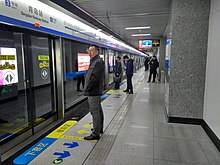
After getting the approval from the State Council, the government announced on 18 August 2009 that Qingdao is ready to spend more than 29 billion yuan ($4.2 billion) before 2016 on its subway construction. Construction of 54.7 km (34.0 mi) of subway line 3 was completed before 2016 with a total investment of 29.2 billion yuan ($4.3 billion). Metro Line 3 is the first line in function and opened on 16 December 2015. In the long term, the city plans to build eight subway lines in downtown and some suburban districts, which account for 231.5 km (143.8 mi) in future.[55] The system has an operating length of 243 km (151 mi), lines in operation including Line 1, Line 2, Line 3, Line 8, Line 11, and Line 13.
Tramway[]
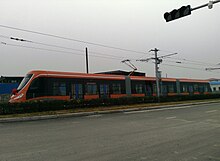
The Qingdao Tram (official name: Modern tram demonstration line) of Chengyang District, Qingdao, is a tram system operating in Chengyang District, Qingdao, China. It opened in 2016. The Qingdao Public Transport Group Rail Bus Co., Ltd. is responsible for operation and management. The system is only composed of 1 tram line.
Culture[]
Architecture[]

There are a large number of German-style buildings in Qingdao's city center, a remarkable fact considering the German leased-territory period only lasted 16 years (1898–1914). The unique combination of German and Chinese architecture therein, combined with German demographic roots and a large Korean expatriate population, gives Qingdao a rather distinct atmosphere. An old saying described Qingdao as a city of "red tiles green trees, blue sky and blue sea." This saying indeed gives a picture of bird view of Qingdao. A larger number of areas in former foreign styles are well preserved. Although the new city area is under large-scale reconstruction, the old city area (especially the western part of Shinan District) still retains many traditional buildings.

Notable people[]
- James R. Lilley, U.S. diplomat
- Ma Jian (马建)
- Xiao Hong (萧红)
- Xiao Jun (萧军)
- Duanmu Hongliang (端木蕻良)
- Erin Pizzey, (was born in Qingdao)
- Li Zhaoxing (李肇星)
- Zhang Ruimin (张瑞敏)
- Victoria Song (宋茜, f(x))
- Huang Zitao (黄子韬, musician, actor)
- Huang Bo (黄渤)
- Zhang Jike (张继科)
- Gao Fenghan (高凤翰)
- Toshiro Mifune (was born in Qingdao)
- Li Cunxin (李存信)
- Huang Xiaoming (黄晓明)
- Chen Hao (陈好)
- Xia Yu (夏雨)
- Fan Bingbing (范冰冰, born in Qingdao)
- Bai Baihe (白百合)
- Hao Haidong (郝海东)
- Wang Dong (王栋, midfielder for Qingdao Huanghai)
- Zhang Juanjuan (张娟娟 ,archer)
- Malcolm H. Wiener, (was born in Qingdao)
- Ni Ping (倪萍)
- Tang Guoqiang (唐国强)
- Chen Meng (陈梦)
Movies shot in Qingdao[]
- A Little Red Flower (送你一朵小红花 2020) 2020
- A Better Tomorrow 2018 (英雄本色2018) 2016
- The Great Wall (长城) 2016
- Underdog Fight (硬汉) 2008
- Underdog Fight II (硬汉 II) 2013
- Ocean Heaven (海洋天堂) 2010
- Beauty Remains (美人依旧) 2005
Language[]
During the city's leased-territory days, German, the official language, was rigorously taught and promoted. Since the demise of Germany's colonial empire after World War I, the German language is all but gone, leaving little impact on the local languages. A local accent known as Qingdao dialect (Chinese: 青岛话; pinyin: Qīngdǎo huà) distinguishes the residents of the city from those of the surrounding Shandong province. Due to the efforts by the city government to promote standard Mandarin, most educated people can speak standard Mandarin in addition to their native dialect. With reform policies and English teaching, some young citizens have been taught English and many can converse with English-speaking foreigners. Business and traffic signs in English are becoming more and more common.
Festivals[]
Notable festivals include:
- Qingdao International Horticultural Exposition 2014 is the biggest international fair that has been held in the history of the city.
- Qingdao International Beer Festival in August/September, held annually since 1991.
Media[]
Qingdao previously had a large German community and a German garrison, so three German newspapers operated in Qingdao.[56] German papers included (traditional Chinese: 泰東古今鑑; simplified Chinese: 泰东古今鉴; pinyin: Tàidōng Gǔjīn Jiàn;[57] weekly newspaper published until 1906, included Die Welt des Ostens, Altes und Neues aus Asiens drei Kaiserreichen, a cultural supplement),[56] the Tsingtauer Neueste Nachrichten and the (a daily paper published from 1908 to 1912, referring to the Kiautschou (Jiaozhou) Bay concession). German publishing in Qingdao ended after World War I and the beginning of the Japanese administration.[57]
A 1912 publication of the United States Department of Commerce, Bureau of Foreign and Domestic Commerce said that the of Tianjin was read in Qingdao, and that major newspapers from Shanghai were also read in Qingdao.[58]
Tourism[]
Qingdao attracts many tourists due to its seaside setting and temperate weather. Parks, beaches, sculptures and unique German and modern architecture line the shore. Its centrally located tourist information center, the "Qingdao Information Center for International Visitors for International Visitors," is located on Middle Hong Kong Road (香港中路).
Qingdao's major attractions include:
Western Shinan district[]
- Zhan Qiao (Pier, 栈桥)
- Little Qingdao Isle (小青岛)
- Tian Hou Temple (天后宫), Qingdao Folk Museum
- Badaguan (八大关; 'Eight Great Passes'), the older area of town with some surviving German and Japanese architecture.
- Lu Xun Park, named after Lu Xun, modern Chinese writer and critic, who lived and taught in the 1930s.
- Zhongshan Park, named after the style name 'Zhongshan' of Sun Yat-sen, a famous modern Chinese politician.
- Xiao Yu Shan (小鱼山; 'Little Fish Hill')
- The twin-spired St. Michael's Cathedral (天主教堂; Kathedrale St. Michael), a notable example of Qingdao's famous Neo-romanesque architecture, designed by German architect Alfred Fräbel, completed in 1934.
- Qingdao Aquarium (青岛水族馆)
- Jiaozhou Governor's Hall (提督府), office building of former German governors (Gouverneurspalast) and former municipal government
- Xinhao Hill (信号山)
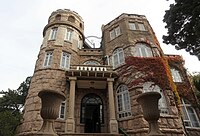
Hua Shi Lou in the Eight Great Passes

Former site of the headquarters of the German Administration

The Protestant Church (Evangelische Kirche) (基督教堂)
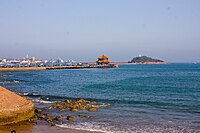
The pier on the seafront
A view of Qingdao
Eastern Shinan district[]
- May Fourth Square (Platz des vierten Mai), Coastal plaza with the Wind of May sculpture
- Tsingtao Brewery (Tsingtao-Brauerei), founded by Germany and the most exported beer from China.
- Zhanshan Temple (Dschanschan-Tempel), Qingdao's oldest Buddhist temple.
Laoshan district[]
- Lao Shan (Mount Lao, Lauschan, 崂山), 40 km (25 mi) east of Qingdao, the most famous Taoist mountain with Taoist retreat – Great Purity Palace (太清宫)
Education[]
Higher Education[]
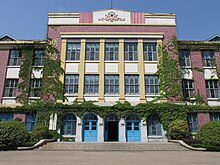
Qingdao is home to a large number of higher education institutions. Ocean University of China, formerly called Ocean University of Qingdao, is the most important university of maritime sciences in China. In addition, the Qingdao University, the Qingdao University of Science and Technology as well as the Qingdao Technological University have also been integral parts of higher education in Qingdao for decades. Shandong University Qingdao (SDUQ) established since 2016, belonging to Shandong University System. Other institutions include:
- China University of Petroleum, completed its relocation from Dongying to Qingdao in 2012
- Shandong University of Science and Technology, main campus is based in Qingdao since 2003
- Qingdao Agricultural University, main campus is based in Qingdao since 2007
- Qingdao Technical College
- Qingdao Binhai University, located at Huangdao.
Shandong University was located in Qingdao from 1909 to 1936. A new branch campus of the university is under construction in Aoshanwei Town, Jimo.
International schools[]
- Korean International School of Qingdao
- Malvern College Qingdao
- Pegasus California School, Qingdao
- International School of Qingdao
- Qingdao Amerasia International School
- Qingdao No.1 International School
- Qingdao Oxford International College
- Yew Chung International School of Qingdao
- Belt&Road Collaborative Innovation College (BRCIC)[59]
Secondary schools[]
- Qingdao No. 2 High School
- Qingdao No. 58 School
- Qingdao No. 1 High School
- Qingdao No. 9 High School
- and so on
Sports[]
Stadiums[]
- Guoxin Gymnasium (Qingdao city sports center)
- Yizhong Sports Center
- Qingdao Tiantai Stadium
- Hongcheng Stadium
2008 Olympic Summer Games[]
During the 2008 Summer Olympics, Qingdao and Beijing cohosted the Olympic Sailing competitions.[60] In Qingdao, the events took place along the shoreline by the city. These events were hosted at the Qingdao International Sailing Centre and held in , near the city's central business district. An international broadcasting center and purpose-built hotel were constructed for the Games.
Motorsport[]
The IndyCar Series signed a contract with the Qingdao city council to hold an IndyCar race in Qingdao in 2012. The subsequently canceled race was supposed to take place on a 6.23 km (3.87 mi) street circuit[61][62]
Sister cities[]
Qingdao has 26 sister cities.[63]
| City | Country | Year of Agreement |
|---|---|---|
| Acapulco | 1985 | |
| Adelaide[64] | 2014 | |
| Bilbao | 2004 | |
| Daegu | 1993 | |
| Galway | 1999 | |
| Iloilo City | 2003 | |
| Klaipėda | 2004 | |
| Long Beach | 1985 | |
| Makassar | N/A | |
| Mannheim | 2016 | |
| Miami | 2005 | |
| Montevideo | 2004 | |
| Nantes | 2005 | |
| Nes Ziyyona | 1997 | |
| North Shore City | 2008 | |
| Odessa | 1993 | |
| Paderborn | 2003 | |
| Perm | 2003 | |
| Puerto Montt | 1999 | |
| Sankt Petersburg | 2006 | |
| Shimonoseki | 1979 | |
| Southampton | 1998 | |
| Velsen | 1998 | |
| Vila Velha | 2009 | |
| Wilhelmshaven | 1992 | |
| Faisalabad | 2021[65] |
See also[]
- List of twin towns and sister cities in China
- Shandong
Notes[]
- ^ See German East Asia Squadron, Battle of Coronel and Battle of the Falkland Islands for fleet engagements.
References[]
Citations[]
- ^ Jump up to: a b Cox, Wendell (2018). Demographia World Urban Areas. 14th Annual Edition (PDF). St. Louis: Demographia. p. 22. Archived (PDF) from the original on 3 May 2018. Retrieved 16 June 2018.
- ^ 2017中国青岛青岛概况 - 中文 - 青岛之窗 - 让青岛走向世界,让世界了解青岛. www.qingdaochina.org. Archived from the original on 6 March 2019. Retrieved 4 March 2019.
- ^ 中央机构编制委员会印发《关于副省级市若干问题的意见》的通知. 中编发[1995]5号. 豆丁网. 19 February 1995. Archived from the original on 29 May 2014. Retrieved 28 May 2014.
- ^ Jump up to: a b "Demographia World Urban Areas" (PDF). 2021.
- ^ "China Beer" (PDF). Archived from the original (PDF) on 4 March 2016. Retrieved 13 June 2013.
- ^ "The Global Financial Centres Index 28" (PDF). Long Finance. September 2020. Retrieved 26 September 2020.
- ^ "China's Top 10 Most Livable Cities". hnloudi.gov.cn. Hunan Loudi Official Government. 28 March 2012. Archived from the original on 10 April 2013. Retrieved 18 June 2014.
- ^ "List of 10 Most Livable Cities in China Issued". 9 July 2009. Archived from the original on 26 April 2011. Retrieved 18 December 2010.
- ^ Lin Liyao (蔺丽瑶) (27 July 2011). "Top 10 livable cities in China 2011". China.org.cn. Archived from the original on 23 September 2012. Retrieved 10 September 2012.
- ^ "China Focus: What to expect from SCO summit in Qingdao". Xinhua. Archived from the original on 29 June 2018. Retrieved 29 June 2018.
- ^ "The World According to GaWC 2020". GaWC - Research Network. Globalization and World Cities. Retrieved 31 August 2020.
- ^ "Nature Index 2020 Science Cities | Supplements | Nature Index". www.natureindex.com. Retrieved 16 October 2020.
- ^ Gottschall, Terrell (2003). By Order of the Kaiser, Otto von Diederichs and the Rise of the Imperial German Navy 1865–1902. Annapolis: Naval Institute Press. p. 146. ISBN 978-1-55750-309-1.
- ^ Matzat, Wilhelm (May 2003). "Landmann Gottfried 1860–1926 Uhrmacher, Optiker, Bierbrauer" [Gottfried Landmann, 1860–1926: Watchmaker, Optician, Beer Brewer]. tsingtau.org (in German). Wilhelm Matzat. Archived from the original on 28 July 2011. Retrieved 9 June 2010.
- ^ Jump up to: a b Schultz-Naumann, Joachim (1985). Unter Kaisers Flagge: Deutschlands Schutzgebiete im Pazifik und in China einst und heute [Under the Kaiser's Flag: Germany's protected areas in the Pacific and in China then and now] (in German). Universitas. p. 183. ISBN 978-3-8004-1094-1.
- ^ Matzat, Wilhelm (May 2003). "Germania Brauerei und ihre Angestellten 1903–1914" [Germania Brewery and its Employees]. tsingtau.org (in German). Wilhelm Matzat. Archived from the original on 12 August 2014. Retrieved 9 June 2010.
- ^ Li (李), Si (斯). 1904年06月01日 胶济铁路通车. www.todayonhistory.com. Archived from the original on 3 September 2014. Retrieved 1 September 2014.
- ^ Duffy, Michael (22 August 2009). "Primary Documents – Count Okuma on the Japanese Capture of Tsingtao, 15 August 1914". firstworldwar.com. Archived from the original on 7 August 2014. Retrieved 28 July 2014.
- ^ "Germans lose possessions in China". The Independent. 16 November 1914. Archived from the original on 30 December 2012. Retrieved 24 July 2012.
- ^ A. Whitney Griswold, The Far Eastern Policy of the United States (1938) pp. 239–68.
- ^ Griswold, The Far Eastern Policy of the United States (1938) pp. 326–28.
- ^ Toyokichi Iyenaga (26 October 1914). "What is Kiaochou worth?". The Independent. Archived from the original on 30 December 2012. Retrieved 24 July 2012.
- ^ Schultz-Naumann, p. 182
- ^ Schultz-Naumann, Joachim (1985). Unter Kaisers Flagge: Deutschlands Schutzgebiete im Pazifik und in China einst und heute (in German). Universitas. p. 183. ISBN 978-3-8004-1094-1.
- ^ Schultz-Naumann, p. 184
- ^ 2016年统计用区划代码和城乡划分代码:青岛市 (in Chinese). National Bureau of Statistics of the People's Republic of China. 2016. Retrieved 1 February 2018.
统计用区划代码 名称 370201000000 市辖区 370202000000 市南区 370203000000 市北区 370211000000 黄岛区 370212000000 崂山区 370213000000 李沧区 370214000000 城阳区 370281000000 胶州市 370282000000 即墨市 370283000000 平度市 370285000000 莱西市
- ^ Jump up to: a b "Index" 中国气象数据网 - WeatherBk Data. China Meteorological Administration. Archived from the original on 23 September 2017. Retrieved 9 November 2018.
- ^ Jump up to: a b 自然地理 [Geography] (in Chinese). Qingdao: Shinan District Information Office. Archived from the original on 2 June 2010. Retrieved 29 June 2010.
- ^ "Archived copy". Archived from the original on 18 March 2013. Retrieved 18 February 2013.CS1 maint: archived copy as title (link)
- ^ Jacobs, Andrew (5 July 2013). "Huge Algae Bloom Afflicts Coastal Chinese City". The New York Times. Archived from the original on 9 July 2013. Retrieved 5 July 2013.
- ^ 青岛城市介绍 (in Chinese). Weather.com.cn. June 2011. Archived from the original on 28 June 2011. Retrieved 1 June 2011.
- ^ "Climatological Normals of Qingdao". Hong Kong Observatory. Archived from the original on 22 November 2008. Retrieved 10 April 2010.
- ^ d.o.o, Yu Media Group. "Qingdao, China - Detailed climate information and monthly weather forecast". Weather Atlas. Archived from the original on 9 July 2019. Retrieved 9 July 2019.
- ^ Annette S. Biener: Das deutsche Pachtgebiet Tsingtau in der Provinz Schantung, 1897–1914. Institutioneller Wandel durch Kolonialisierung (Studien und Quellen zur Geschichte Schantungs und Tsingtaus. Bd. 6). Matzat, Bonn 2001, ISBN 3-924603-05-7.
- ^ 韩国旅客位居北京入境外国人之首. 8 October 2009. Archived from the original on 26 November 2009. Retrieved 1 December 2009.
- ^ Jump up to: a b c "Qingdao Shinan District Investment Environment Study 2007", Report, KPMG Huazhen, 2007, retrieved 10 June 2010[permanent dead link]
- ^ 2019年青岛GDP发布,含金量到底多少?|界面新闻. www.jiemian.com (in Chinese). Retrieved 23 February 2020.
- ^ "Gibson Qingdao Factory – All Epiphone... All The Time!". Epiphone.com. Archived from the original on 9 March 2012. Retrieved 24 February 2012.
- ^ Gardiner, Ginger. "High Wind in China". www.compositesworld.com. Archived from the original on 25 May 2017. Retrieved 27 May 2017.
- ^ 中国公路信息服务网-公路地图 (in Chinese). 中国公路信息服务网. Archived from the original on 16 January 2013. Retrieved 12 January 2013.
- ^ Eimer, David (8 January 2011). "China builds world's longest bridge". The Telegraph. London. Archived from the original on 6 May 2018. Retrieved 23 March 2013.
- ^ New Qingdao model of BRI cooperation
- ^ Qingdao Port became the first port in the country whose sea-rail combined transport exceeded one mil
- ^ Qingdao port sees upsurge in cargo handling capacity Archived 10 March 2005 at the Wayback Machine. People's Daily. Retrieved on 2012-11-12.
- ^ "Ports & World Trade". www.aapa-ports.org. Archived from the original on 4 May 2011. Retrieved 3 July 2014.
- ^ Ferries Korea-China Archived 19 August 2010 at the Wayback Machine. Seat61.com. Retrieved on 2012-11-12.
- ^ "About Dongjiakou port". www.qingdao-port.com/. Qingdao Port International Co. Ltd. Archived from the original on 7 November 2017. Retrieved 31 October 2017.
- ^ "青岛胶东国际机场正式转场运营". 12 August 2021.
- ^ "Qingdao North Railway Station: Location, Trains, Transportation". www.travelchinaguide.com. Retrieved 15 June 2020.
- ^ For a number of years before August 2008, travellers not from Qingdao were often confused because railway tickets to Qingdao showed the destination as "Sifang". Those trains were headed to Qingdao's Sifang station as a temporary measure. Once renovations to the larger Qingdao Railway Station were complete, the name of the destination reverted to "Qingdao".
- ^ 杨传忠 (17 October 2012). 济青高铁建设近年无望 济青1小时生活圈得等等. Qilu Evening News (in Chinese).
济南铁路局胶济客专公司一位负责人说,胶济客专的客运正线长362.5公里,设计速度最高250公里/小时,现在行车时速为200公里.
- ^ 列车时刻 (in Chinese). Qingdao railway station. Archived from the original on 8 January 2013. Retrieved 12 January 2013.
- ^ 民生追访:4月10日起青岛至北京一站直达 高铁票_555彩票_555彩票娱乐网_555彩票官方认证平台-首页. www.3box.cc. Retrieved 23 February 2020.
- ^ 青岛发布2018年社会责任报告 全年客运总量7.37亿人. qd.ifeng.com. Retrieved 23 February 2020.
- ^ "$4.3 billion budget to boost Qingdao subway construction". 19 August 2008. Archived from the original on 22 August 2009.
- ^ Jump up to: a b Walravens, p. 90 Archived 2 January 2016 at the Wayback Machine.
- ^ Jump up to: a b Walravens, p. 91 Archived 2 January 2016 at the Wayback Machine.
- ^ United States Bureau of Foreign and Domestic Commerce, p. 188 Archived 2 January 2016 at the Wayback Machine. "Tageblatt für Nord China, a German paper published in Tientsin, and the leading papers published in Shanghai are also largely read in Tsingtau."
- ^ "Archived copy". Archived from the original on 4 November 2018. Retrieved 4 November 2018.CS1 maint: archived copy as title (link)
- ^ "2008 Beijing Olympic Sailing Competition". sailing.org. Retrieved 24 June 2021.
- ^ IndyCar (10 November 2011). "INDYCAR: Series Confirms China Race". SPEED Channel. Fox Sports. Archived from the original on 13 November 2011. Retrieved 11 November 2011.
- ^ "IndyCar scheduled August race in China has been canceled". Washington Posts. Archived from the original on 15 December 2018. Retrieved 16 June 2012.
- ^ "Qingdao sister cities". Retrieved 12 April 2020.
- ^ "Qingdao - Sister city of Adelaide". Retrieved 19 May 2020.
- ^ "Faisalabad, Qingdao sign Letter of Intent to develop sister city ties". Associated Press of Pakistan. 27 April 2021. Retrieved 28 April 2021.
Sources[]
- Gottschall, Terrell D. By Order of the Kaiser: Otto von Diederichs and the Rise of the Imperial German Navy 1865–1902. Annapolis: Naval Institute Press. 2003. ISBN 1-55750-309-5
- Schultz-Naumann, Joachim. Unter Kaisers Flagge: Deutschlands Schutzgebiete im Pazifik und in China einst und heute [Under the Kaiser’s Flag, Germany’s Protectorates in the Pacific and in China then and today]. Munich: Universitas Verlag. 1985.
- Miscellaneous series, Issues 7–11. United States Department of Commerce, Bureau of Foreign and Domestic Commerce, 1912.
- Walravens, Hartmut. "German Influence on the Press in China". In: Newspapers in International Librarianship: Papers Presented by the Newspaper Section at IFLA General Conferences. Walter de Gruyter, 1 January 2003. ISBN 3110962799, ISBN 9783110962796.
- Also available at the website of the Queens Library – This version does not include the footnotes visible in the Walter de Gruyter version.
- Also available in Walravens, Hartmut and Edmund King. Newspapers in international librarianship: papers presented by the newspapers section at IFLA General Conferences. K.G. Saur, 2003. ISBN 3598218370, ISBN 9783598218378.
External links[]
| Wikimedia Commons has media related to Qingdao. |
| Look up Qingdao, Tsingtao, or Ch'ing-tao in Wiktionary, the free dictionary. |
| Wikivoyage has a travel guide for Qingdao. |
- Qingdao Government website (in Chinese)
- Qingdao International Academician Port website (in Chinese)
- Study in China Admission System(中国高等院校国际招生管理服务系统) website (in English)
Largest cities or municipalities in the People's Republic of China
China Urban Construction Statistical Yearbook 2018 Urban Population and Urban Temporary Population | |||||||||
|---|---|---|---|---|---|---|---|---|---|
| Rank | Name | Province | Pop. | Rank | Name | Province | Pop. | ||
 Shanghai  Beijing |
1 | Shanghai | SH | 24,237,800 | 11 | Nanjing | JS | 6,572,000 |  Guangzhou  Shenzhen |
| 2 | Beijing | BJ | 18,634,000 | 12 | Hangzhou | ZJ | 6,504,900 | ||
| 3 | Guangzhou | GD | 13,154,200 | 13 | Zhengzhou | HA | 6,261,900 | ||
| 4 | Shenzhen | GD | 13,026,600 | 14 | Xi'an | SN | 5,866,100 | ||
| 5 | Tianjin | TJ | 12,968,100 | 15 | Shenyang | LN | 5,651,200 | ||
| 6 | Chongqing | CQ | 11,488,000 | 16 | Qingdao | SD | 5,127,000 | ||
| 7 | Wuhan | HB | 9,180,000 | 17 | Harbin | HL | 4,860,000 | ||
| 8 | Chengdu | SC | 8,379,700 | 18 | Changchun | JL | 4,564,000 | ||
| 9 | Hong Kong | HK | 7,448,900 | 19 | Hefei | AH | 4,292,400 | ||
| 10 | Dongguan | GD | 6,850,300 | 20 | Jinan | SD | 4,154,900 | ||
- Qingdao
- Populated coastal places in China
- Port cities and towns in China









